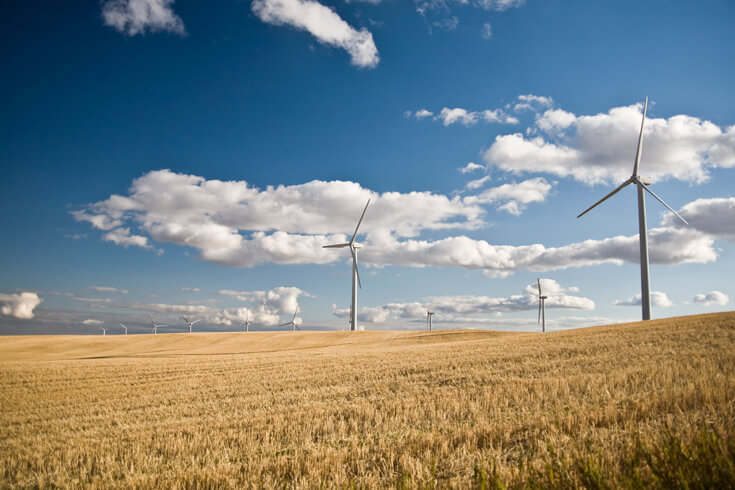In traditional TV westerns, it’s easy to tell the goodies from the baddies: good guys wear white hats and bad guys wear black hats. Just as TV wipes away moral ambiguity in order to present an oversimplified, easy-to-digest moral landscape, so too is the corporate universe often presented in stark terms. The white hats, like Elon Musk’s Tesla and Solar City, work on the side of angels to bring clean, everlasting light to the masses. The black hats, ExxonMobil as lead villain with the Koch brothers in a supporting role, manipulate public opinion, bribe politicians, and work to maintain fossil fuel’s stranglehold on energy systems.
There’s some truth to these caricatures. Musk is indeed motivated to solve the climate crisis. ExxonMobil and Koch Industries, among others, have funded (and still fund) climate-skeptical, antiscience think tanks and political action groups. Many of their fossil fuel peers work to block clean-tech competition and lobby against environmental regulations, including any sort of carbon price. And the well-documented predatory attitude of some in the financial sector post–bank bailouts in 2008 and 2009 remains a particular source of bile for many. But reality is far more complicated than these examples might imply.
Certainly, there are good and bad corporate actors, just as there are honest and dishonest accountants. But the vast majority of companies and investors, like that of all human categories, play somewhere in the middle. Certainly, all are motivated, to a greater or lesser extent, by self-interest, and many are prone to willfully ignoring what appears most inconvenient to that self-interest. But, broadly speaking, corporate leaders are equally considerate of human decency, have real concern for the future, and respect traditional norms of truth-telling and rational debate when it comes to important risks. And they generally provide consumers with the goods and services they want. If they didn’t, they’d go out of business.
Is Facebook a white hat or a black hat? Walmart? Facebook’s notoriously incautious approach to individual privacy and willful blindness to its own role as agent (and beneficiary) of nefarious political actors was enough to convince me to delete my profile in protest. Yet Facebook provides huge demand for clean energy as it looks to power all its data centres with low-carbon sources. Those efforts are real, evidenced by the company meeting a short-term target of 50 percent clean energy by 2018. New data centres come online matched with a power purchase agreement (PPA) to offset that energy load with renewables from the grid. Walmart, on the other hand, has ravaged local economies and communities by leveraging its buying power to strong-arm thousands of retail outlets out of business. And, of course, its treatment of employees is not top tier. But Walmart doesn’t just lower the cost of underwear, socks, and televisions. It’s fast becoming a clean-tech star itself, both within its own operations and by leveraging its purchasing power to force suppliers into making better choices about their own energy use—just as it uses that same leverage to squeeze profits.
It’s tempting to divide the corporate world into white hats and black hats, but aside from the obvious and outlying cases—big tobacco’s outright lies to the US Congress about health effects, Exxon’s repression of public debate on climate risk, or Shell’s trampling of human rights in Nigeria—it’s not that simple. Most corporations operate as grey hats, neither evil nor good, merely pursuing profit within the law and generally abiding by the normal bounds of human decency.
A more interesting question is: How might we turn those many grey hats white? The vast majority of corporate leaders don’t view themselves or their organizations as moral agents in the transition to a low-carbon economy but rather as mere actors in a larger economic scene. What sort of nudge might better align that neutrality with a good outcome in our shared climate fight?
Understanding the attitudes adopted by various actors in the traditional energy sector is instructive as we seek to enlist corporate leaders in the climate fight. Aside from the malfeasance demonstrated by black hats like ExxonMobil, we might divide the sector’s role in climate action into three categories: forced actors, who view emission constraints as legal burdens they must abide; willing actors, who dabble in clean energy independent of their legal obligations; and leading actors, who enthusiastically push the normal limits of corporate constraints to become active forces for positive change across both technology and policy.
Forced actors form the vast majority of energy giants. Most now acknowledge climate risk and view the transition to a low-carbon economy as a constraint placed on their normal mode of business. Investments in clean energy are driven by a sense of regulatory compliance rather than strategic advantage. Clean tech is applied within existing operations to reduce the pollutants associated with the production of their primary product—fossil fuels—in order to comply with regulatory pressure. Rather than finding or developing alternative sources of energy, they work to green their products under the assumption that demand for them will not falter.
Cenovus is a typical forced actor. A stellar performer in Canada’s heavy-oil patch, its two Alberta plants are squeaky clean, with little to no above-ground toxins. By melting bitumen below ground instead of mining the stuff in an open pit, they produce no tailings ponds. But it takes a massive amount of natural gas to convert that bitumen to usable oil. First, the company burns enormous quantities of the stuff to melt the bitumen. Then, it strips hydrogen from yet more natural gas to add to the heavy oil to make it resemble conventional oil. Its focus is to reduce that energy intensity—the amount of natural gas required per barrel of oil. Cenovus is as well-meaning a heavy-oil company as you’ll find, taking a lead role in defining best practices within its industry and supporting Alberta’s carbon-pricing policies. It’s hardly the devil, but it’s also incapable of championing a low-carbon future; the asset it’s sitting on precludes it taking on that role.
Willing actors go further than established best practices. They contribute to our understanding of climate risk and engage in research and dialogue about what sorts of energy systems are needed to keep global temperatures down. Many embrace the transition away from coal and heavy oil to natural gas as a primary response to emission constraints but also make investments in nonfossil energy production, like wind, solar, or biofuels. This can sometimes be a bit of a show, but it’s more often a genuine effort to explore ways to diversify their business. If they push the bounds of technology, it’s generally to support the development of carbon capture and storage.
TransAlta is a typical willing actor. Once fully committed to coal, it began dabbling in wind after being prodded by its sustainability officer, Bob Page. In 2002, the company bought Vision Quest, its first wind farm, from Canadian wind pioneer Fred Gallagher for just under $40 million. At the time, the business community saw the deal as largely immaterial, although a couple of analysts at UBS Warburg wrote, “There is mildly positive strategic significance.” How right they were! Seeing decent returns, TransAlta stuck with it, deploying hundreds of millions annually into expanding that “immaterial” side of its business.
Eventually, the company spun off its renewables division into a separate publicly traded company. Beginning in late 2014, while investors watched in horror as the value of TransAlta’s coal assets crashed, their spirits (and equity) were lifted by the 70 percent ownership TransAlta had retained in that spinoff—the value of which kept rising. At one point, that share of ownership accounted for the entire value of the enterprise! What Andrew Kuske and Ronald Barone began as an experiment came to form the basis of substantial, long-term value. It will be instructive to see how much that dynamic informs their peers going forward, as heavy oil goes the way of coal.
Leading actors believe they can change global energy demand by building alternatives to fossil fuels. Innovation in real alternatives is not some external variable for them. It’s an internal drive, a way to define their corporate ambitions and motivate their engineering and finance teams. Innovation is a potential source of long-term strategic advantage against their slower-moving, more passive peers.
Compare North America’s willing actor TransAlta to Ørsted, a Danish peer. Back in 2010, more than 70 percent of Ørsted’s power plants burned fossil fuels. In 2013, it announced that it would divest from these and move into renewables. The company proved to be serious and moved aggressively into offshore wind, acquiring and developing assets around the world. Today, that 70 percent share comes from renewables. And Ørsted isn’t done. By 2020, less than one-tenth of its fleet will be carbon emitting.
Second only to Ørsted is Equinor (formerly Statoil). The Norwegian oil-and-gas giant changed its name to reflect the decision to become a new kind of energy company. I first encountered Statoil in the mid-2000s, when I attended a clean-tech conference in Stavanger, Norway. At the time, I was weary of North American corporate executives endlessly debating the existence of climate disruption, never mind its relevance to their industry. Yet, in Stavanger, I witnessed the CEO of one of the world’s largest fossil fuel companies excitedly explain the engineering challenge of developing massive, floating offshore wind turbines. At the end of his talk, I asked timorously: “You’re an oil-and-gas company. Why are you taking on the engineering risk of offshore wind?” I was dumbfounded by his answer, delivered in a gentle Norwegian lilt: “Because it is the right thing to do. And because we are able to do it!”
And they did. Equinor developed Hywind, a floating platform capable of supporting massive wind turbines twice the height of the Statue of Liberty. Instead of deploying existing wind technology, it committed capital and expertise to improving it. The world’s first offshore floating wind farm, off the coast of Scotland, produces more wind more of the time than conventional wind farms because over deep water is where the best winds are found.
The key point is not that Equinor built a wind farm. Lots of companies do that. It’s the company’s commitment to changing the economics of wind, to using its own muscle to make wind more competitive against oil and gas in a country where electric vehicles pose a profound threat to oil demand. When asked why it has chosen to play a role at the cutting edge of renewables, its answer is disarmingly simple: “No other company combines our decades of offshore experience with our project execution capabilities.”
In other words, because it’s an existing energy giant, it’s in the best position to be a new kind of energy giant.
For now, the broader industry remains entrenched as forced actors. Its investment in clean tech remains insignificant compared to the $170 billion spent annually to find new reserves. To highlight this disparity: the Canadian clean-tech industry—a bunch of small enterprises treated as an afterthought within the larger business community—spends more on R&D than the country’s entire oil-and-gas sector combined.
This is not to accuse the large oil-and-gas companies of inaction. But the big bucks still find their way to support the business of selling fuels extracted from the ground. Cenovus had a venture fund that invested in “real” clean tech, but it has since backed off that more progressive approach. Cenovus’s new fund, Evok Innovations, marks a return to the usual focus on technologies to improve existing operations: lower pollutants in tailings ponds, suck more oil and gas from an existing field, make processing operations more efficient, move heavy oil through pipes more easily. These may be good things for Cenovus, but they’re far from transformative.
The larger lesson is that we shouldn’t expect traditional energy companies to drive the transformation we need. Their job remains to deliver what the market demands. But if the clean-tech industry can change what kind of energy faces demand and disrupt traditional energy flows, then there are willing partners in the traditional energy space. The trick is to focus on those companies that have made it the mandate of their executive teams to seek out those opportunities.
So, how do we turn those grey hats white? From a clean-tech entrepreneur’s perspective, you can’t do it directly. Nothing I say or do will convince ExxonMobil to change their view or get BP to invest in solar again. But we can support white hats, like Equinor, ensuring their commitment to low-carbon energy is rewarded in the market. And that, in turn, will push grey hats to white as they see their more progressive peers gaining an advantage. More and more clean-tech partners will come from the energy patch, of that I’m certain.
We should expect the vast majority of energy companies to fight to the bitter end for their right to dig up and burn all of the reserves they carry on their balance sheet, regardless of whether they’re black, grey, or even white hats. Even a clear-minded CEO who decides to support wind, solar, and storage can’t do so at the expense of walking away from the giant pile of coal or oil they’re sitting on. That’s leaving money on the table. That executive is not an evil person; they’re just playing by the rules in a very well-defined game. That’s why it’s the investment community that holds the real keys to change.
As weather gets weirder—hotter, drier, wetter, windier, stormier—untold seismic economic events kick in. Poor Puerto Rico saw it, as did wealthy Houston. The National Oceanic and Atmospheric Administration (NOAA) estimated 2017 losses due to climate in the US alone at $306 billion. Less than half of that was insured. As these losses increase, private insurance will retreat, leaving the bill to corporate and public purses.
Playing defence against these more existential risks is possible. Just as the ability of climate science to attribute individual weather events to long-term climate trends has increased, so too has its ability to provide more granular data on changes that may occur in a given place. Climate science remains probabilistic (as does most risk assessment), but narrowing ranges of uncertainty about specific events are beginning to provide the kind of quantitative language most investors need in order to act. The move from qualitative warnings to quantitative risk assessment will happen slowly, but once it does, investors will react to protect their assets. They’ll have no choice.
Some will disbelieve what the climate-risk quants tell them, of course. They’re free to do so. They could stay long on Miami real estate as flood risk increases; double down on beef production in the US southwest as droughts become more frequent and severe; ignore increased political risk in countries where climate disruption pulls and stretches the social fabric. They may even get away with it for a while, passing the risk off to others also willing to go long on assets that presume a stable climate. But, over time, they’ll either lose or change their minds. Investment culture will change as Bay Street and Wall Street shift from seeing climate as an irrelevant and fuzzy moral issue to one of immediate concern—their concern.
There are some pretty smart folks working to bring climate risk into the clear, actionable, and quantified language of the financial community. One example is the Climate Service, led by CEO James McMahon, who worked directly with NOAA to start his analysis with some of the best climate models and most comprehensive data sets around. Using geographical grids as small as seven square kilometres, the Climate Service links probabilistic assessments of increased risk over some period of time—of fire, extreme heat, flooding, drought, high wind variance, etc.—to other data sets and physical models to estimate direct costs to investors.
An easy case is flooding. Let’s say a fund is looking to buy and upgrade a portfolio of real estate assets. The Climate Service can quantify the cost and probability, over a given range of time, of potential flooding. These projections send a signal to the real estate community that the value of their investments is under immediate threat. The drop in value from climate risk occurs today, not at some future point. Another example might be the long-term value of a rail-transport company. Not only are its tracks and terminals subject to a similar analysis, but increased heat stress on the tracks can be predicted with precision. Trains must slow down when tracks get hot. That brings a steep drop in productivity, which again affects net present value. Good risk analysis brings potential future events into today’s investment decisions.
Leading institutional investors are no dummies. True, it’s been frustrating to watch the financial community all but ignore climate risk thus far. But, when those risks are put to them in a language they understand, and especially when they know every other investor can see the same data, their bets will get much smarter. Flood barriers will get funded to protect assets in place. Places that can’t be defended, like Miami, will see their values plummet. The flippant climate agnosticism I encounter so often when speaking to financial professionals will give way under the stress test of putting your money where your mouth is. Once climate agnostics and climate hawks can place competing bets in a context where the risks are clearly and transparently quantified, there will be a lot fewer agnostics and a lot more hawks.
But this is just playing defence—protecting investments from the coming storm. That’s not enough. We need investors to play offence: deploy their capital to solve the problem itself. No mainstream investor, no matter how large or savvy, sees it as their job to “solve” climate. And, frankly, no investor or institution is large enough to succeed even if they did. Solving climate requires the entire investment community to act in concert, with a new foundation on which to base decisions. Luckily, we might be able to nudge some portion of that community forward in other ways.
From mining to manufacturing, forestry to pharma, aerospace to automotive, all companies need capital and answer to those who provide it. We might characterize the investment community in much the same way as we did the energy giants—as white, grey, or black hats. Those who aggressively back carbon-intensive industries play the role of black hats. Those who move capital into large-scale clean alternatives are white hats. But these two extremes currently represent a tiny minority of the sector.
Just like fossil fuel executives, the vast majority of investors make up the middle ground, the grey hats. There’s a reason for that: professional investors take pride in not allowing political, environmental, or ideological factors to play a role in their decisions, aside from when they directly and provably affect investment returns. The prime directive for a money manager is to generate the highest risk-adjusted return possible given their set of investment choices. Any other consideration is off limits. Sticking your neck out to try to solve the climate problem, even if it’s in everyone’s long-term interest, just isn’t on. Turning grey hats white looks a bit hopeless from this perspective. It’s just not in the DNA of financial investors.
There is a tiny gap in this picture, however. Like all investors, pension funds generate returns, but they do so over a very long horizon. Hence, they have a unique relationship to a healthy economy over many decades. It’s easy to construct an argument that pension funds have a fiduciary obligation to play offence on climate. Unchecked climate risk entails ecological collapse over the coming century; absent a stable ecosystem, there’s little possibility of a healthy economy decades out; without a healthy economy decades out, pension funds cannot meet obligations to which they’re already committed. Hence, they need to make investment decisions in such a way as to reduce climate risk.
It’s odd to think of pension funds as having the longest horizon of any of our institutions, including national governments that have been around for centuries, but in a practicable and actionable way, they do. Another push on pension funds might result from direct communication with their beneficiaries. It’s entirely possible that, if canvassed effectively, the thousands of teachers, public servants, and municipal workers who make up our largest pension funds have a view on the kinds of long-term investments being made on their behalf. They may well advocate that, all else being equal, climate solutions be prioritized as an investment category. Of course, there is normally a firewall between investment managers and those whose money is being managed. And that’s a good thing in the sense that investment professionals are hired precisely to take the burden of decision making off the hands of a fund’s contributors. But maybe that’s also a mistake.
Obviously, one doesn’t want investment decisions driven by a massive mob of well-meaning but financially unsavvy stakeholders. That’s a recipe for disaster. But, as an additional decision-making criterion, prioritizing climate solutions may not be a bad idea. Fund managers would obviously need to balance that expressed preference against a matrix of standard risk-mitigation and due diligence. But, at least, all else being equal, it might tip the balance in the climate’s favour.
Corporate culture is changing, albeit slowly. Most business leaders today understand that climate risk is real and anticipate some kind of regulatory response. The signal from boardrooms has changed from “not relevant to our business” to “we have to deal with this issue; find a way.” Some firms are going so far as to tie executive compensation to internal emissions-reduction targets. (There’s nothing like a bonus structure to focus one’s mind.) That was not the case just five years ago, when the same project needed to be so compelling it was impossible to ignore. This is not unlike other corporate culture shifts, like fixing the gender imbalance: at some point, a new attitude gets normalized around the board table.
The climate debate is much more complicated than simply throwing rocks at corporate giants and blaming them for the mess we’re in. The few obvious black hats aside, the reality on the ground for our corporate leaders is more complex. It’s a mistake to paint them all with the same brush, and doing so does a great disservice to many people who really are trying to solve a difficult and complex problem. Vilifying corporate Canada (or America, or Europe, or China) misses the point; generalizing and promoting anticorporate sentiment is unhelpful. It does far more good to identify and support the white hats and nudge the grey hats to shift their direction.
Excerpted from The Case for Climate Capitalism: Economic Solutions for a Planet in Crisis by Tom Rand. © 2020 by Tom Rand. All rights reserved. Published by ECW Press Ltd. www.ecwpress.com




